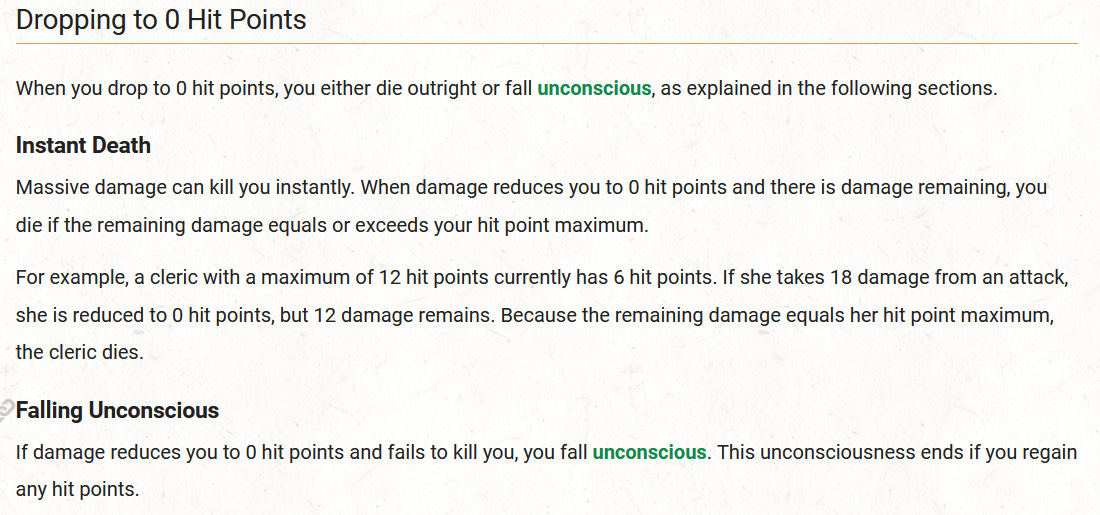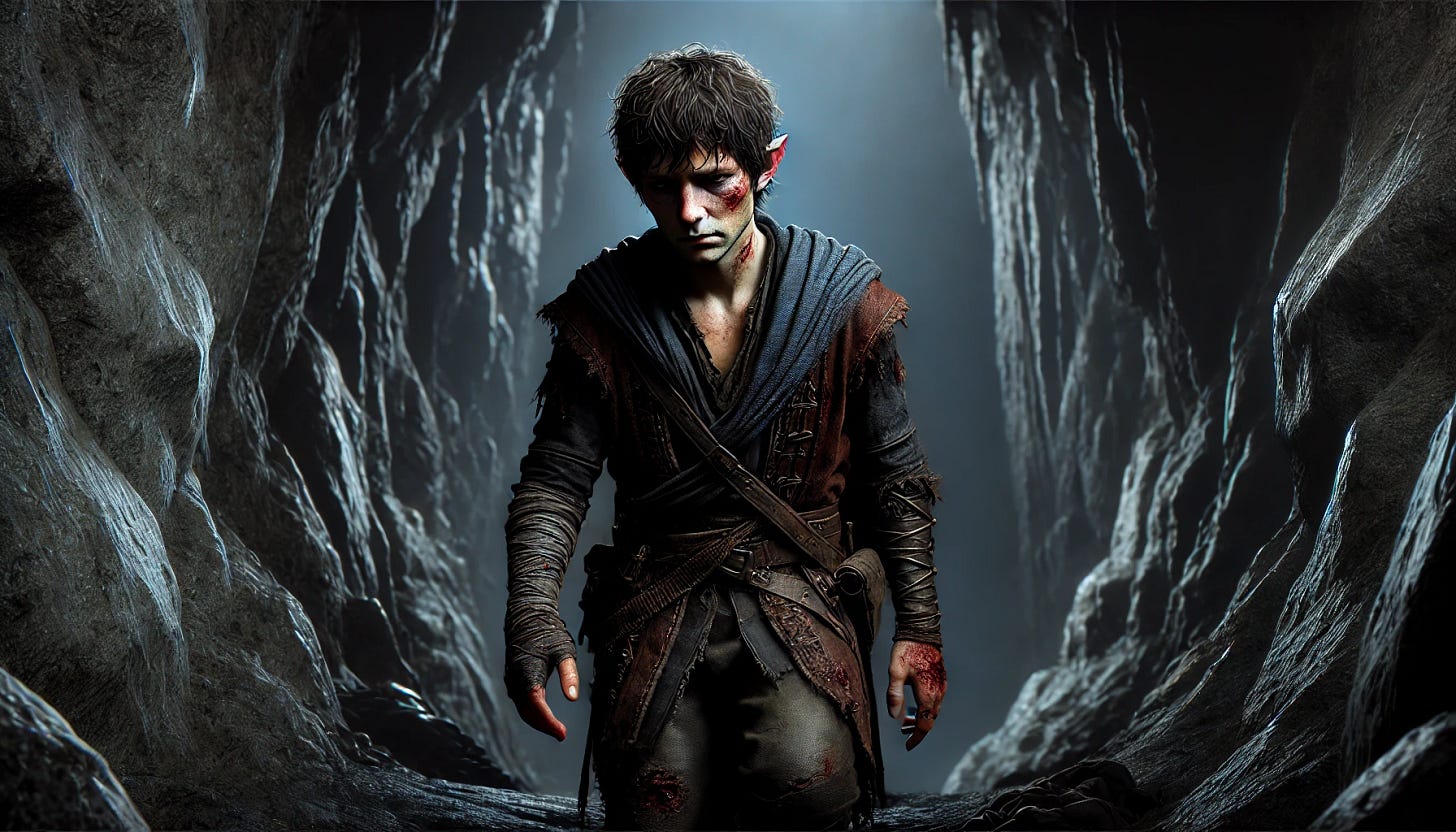Death, the final frontier. This is the moment when your character passes beyond your grasp. This should be about more than rolls of dice. This should be about more than charted metrics. This should be a moment when all of your investment backstory and input comes to a close. It should be upsetting. As a player, you should feel this, and as a Dungeon Master, you should want this from your players. So let’s talk about death and dying and how can we make this more flavorful for your table.
We always face that awkward place where the role playing aspects of Dungeons and Dragons smash into the game mechanics that require dice rolls, charts and numbers. This space is awkward because the flow and suspension of disbelief are jarred by the cold, objective stats and they just don’t feel comfortable in the same space together. With this in mind, it comes as no surprise that one’s ability to add meaning or subjectivity into the death of their character is stuttered or paused as these mechanics first have to unfold.
Ok, fine. We need something to measure the characters death by before we can go into the specifics and narrative of their passing. But are there other modifications we can employ in order to create a more meaningful, tension filled death experience?
Like Garret and I do in our podcast, let’s first go over the rules as written in Dungeons and Dragons 5e. They state:
In my experience, falling unconscious is far more common than instant death. Instant death however does offer a quick transition from the damage roll directly into the narrative about that character’s death. The DM describes the attack and the blow it deals and turns to the player asking them to describe the last things the character hears/sees/feels as they slip from the bounds of life.. you get the idea. But what about unconsciousness? Here is what the Player’s Handbook states:
So there are a couple of things here that make the unconscious status a little skewed: 1. A downed player only makes the saving throw when they start a turn with 0 hit points. If you consider that the player will make a maximum of 5 throws… (2 saves, 2 fails plus one to determine which way it goes) this means that your character is out cold for 6 turns. 5 plus the one they went down on. Considering that most combat on average lasts 3 turns, it is highly unlikely a character would die this way. 2. A character succeeds on a 10 or higher… slightly more than half the d20… shifting the odds in their favor.
One last point before I make my case here for something better; If you are healed while at 0, you are basically back up, in the game like nothing happened. This seems like an easy out to me.
To be clear, I am not making a case for killing characters off. I am simply making the case that if it is too hard for a PC (player character) to die, the player will not have complete investment in the character. The possibility of character death increases the tension at the table and therefore raises the emotional stakes. The party will consider its moves more and sweat out the close calls.
So what can we do to add a little gravity to these situations? Here are 3 variations that will make the situation a little more intense.
The Dungeon Master makes your death saving throws
This scenario is a bit controversial at some tables and I do understand why. It is also important that your table trust you as their DM if you employ this rule. I will explain this from both points of view.
You have fallen unconscious and you are in some kind of dream state or coma. You do not know what is going on. Meanwhile, the battle that you were in rages on. Your party members should also not really know what is going on. So for the player to roll their own death saves on their turn and announce them to the group seems out of line with the tension created by a downed party member. If the party knows that you have succeeded on your first two throws, nobody is going to waste their turn to heal you. They know you’re good… but how? Its a form of meta gaming if you ask me. So a solution is to have the DM roll the saves in secret and keep track. Then, neither the player or the party knows where you stand.
I said this one was controversial and I want to explain why. The player is invested in their character. They have made all the rolls for that character up to this point and now, faced with having to make the most important rolls, they are denied the ability to do so. That is not entirely fair in my book. I am at odds with this. I like it and I don’t like it.
A middle ground solution is to allow the player to make the rolls in secret. They cannot tell the party where they stand.
The Exhaustion Option
I have read over and over again about a house rule of dropping to 0 hit points adding a level of exhaustion. This tends to fix the problem of characters dropping to 0 and falling unconscious only to have healing word cast from across the room and they bounce right back up…over and over again. If a new level of exhaustion is applied to every instance, it will add a consequence multiplier to the scenario. This is pretty good, but I think there could be more to this rule. This tends to simply force the party to long rest as soon as possible and erase the consequence with ease. But let’s consider this in more realistic terms. What if the exhaustion were enhanced a bit to reflect the severity of actually almost dying? What if the exhaustion levels could not be removed by mere rest? Perhaps this exhaustion allows you 1 roll per long rest to determine if you shed 1 level. You could also employ an additional rule here where a die roll determines the minimum length of time exhaustion must endure. Imagine a scenario where dropping to 0 hit points 1 time with 1 level of exhaustion must endure for 1 day before you can roll to shed it.
I will have a working document online soon that will detail these scenarios with tables and metrics for my paid subscribers. As I test those systems out, I will of course update the materials.
A 4e inspired version of the instant death rule
I will admit, this rule is rough and if you are a bit of a sadist, then maybe it is one for your table. In Dungeons & Dragons 4e, the “Bloodied” condition applied to player characters. (this condition is present in 5e but usually regarding monsters and how a player determines how much damage they’ve taken) Bloodied referred to when your character had dropped to or below half their max hit points. The instant death mark was when you sustained enough damage to go below zero to that negative number. Let me explain: In 5e if you have 20 hit points max and you take 40 points of damage (dropping you to zero and then -20) you are dead. End of story. In 4e, if you have 20 hit points maximum and you drop to 10, you are bloodied and if you drop to -10 you are dead. Meaning 30 points of damage kills you in 4e where it takes 40 in 5e. So that right there would increase the gravity of damage as a whole in your game.
I will be adding tables and usable play materials to my substack soon. These will be available for my subscribers to download and use in their game. Keep an eye out for those.
In the meantime check out our episode of the podcast where Garret and I discuss this topic with special guest, Rich Frohman.
Thanks for reading and remember to keep your game deep!








